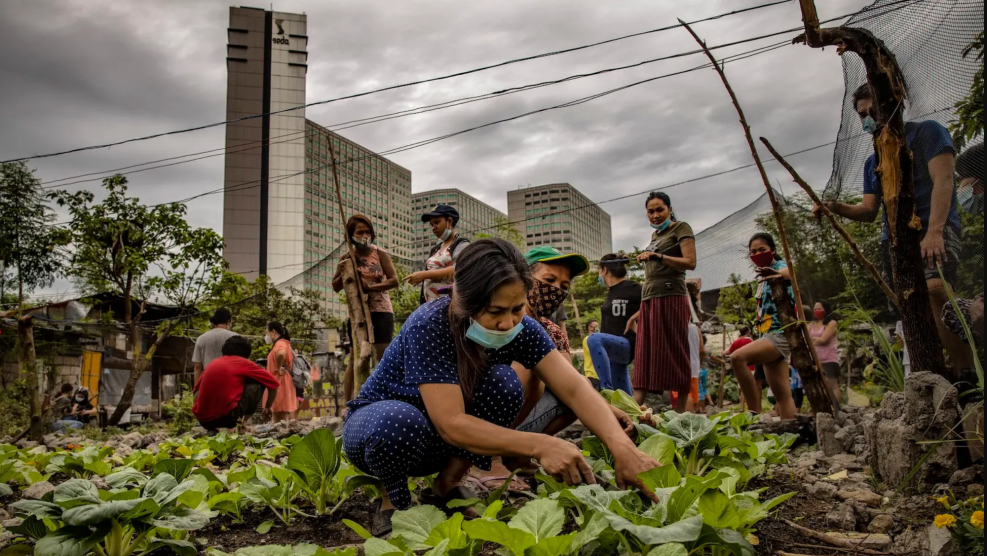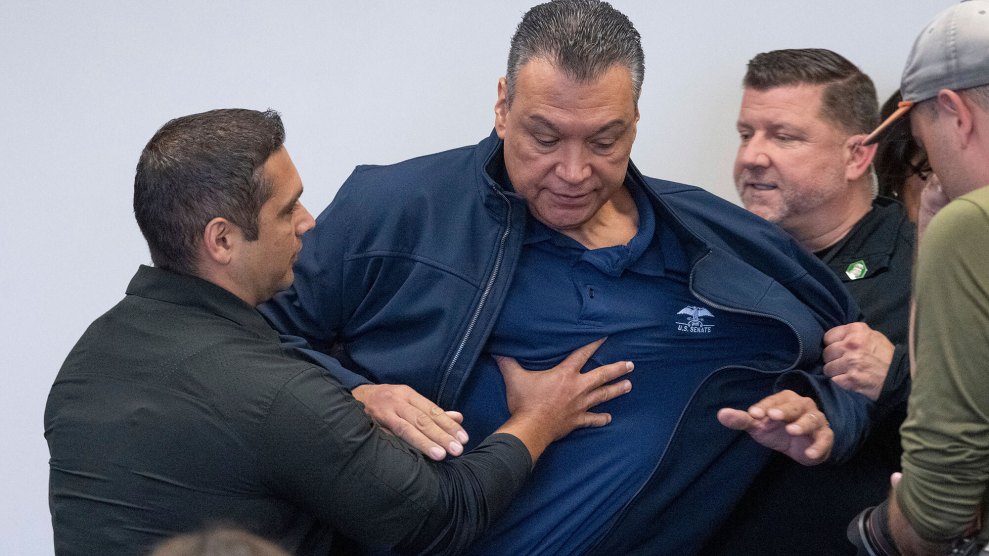
Mother Jones illustration; Getty
The first time Beto O’Rourke came to Fort Bend County, Texas, in April 2017, Cynthia Ginyard, the county Democratic chairwoman, saw people she hadn’t run into in years. Organizers were expecting 125 people; twice that many crammed into a British pub in Sugar Land called Big Ben Tavern, where O’Rourke stood on a chair to be heard and sipped a pint of beer handed to him from the crowd. It was an early sign of the groundswell that would propel O’Rourke into an unexpectedly close race with Republican Sen. Ted Cruz. It was also a sign that something was up in the sprawling suburban county just south of Houston.
When I asked Ginyard not long after if she’d seen local Democrats this engaged before, she laughed. “Oh no—no, no, no, no, no, no, no,” she said. “Previously, let’s say on a scale of 1 to 100, it may have been 40 to 45 percent.” Now, she put Democratic enthusiasm at 80 percent.
In the year and a half since, the intensity has only picked up. When O’Rourke returned to Sugar Land in mid-October, 1,800 voters filled a standing-room-only Marriott ballroom.
Fort Bend County is one of the fastest growing counties in Texas and the most racially diverse county in the country—almost equally comprised of African American, Asian American, Hispanic, and white residents. It is a place O’Rourke absolutely needs to win—and one where Democrats seldom do.
In 2016, after decades of Republican dominance, Hillary Clinton carried the county by seven percentage points. But down ballot, there was little evidence of a sea change. Democrats lost a county commissioner and left all but a handful of Republican candidates unchallenged. Five-term Republican Rep. Pete Olson, whose district covers most of the county, dispatched a Democratic opponent by his narrowest margin in years—19 points.
Fort Bend may be the ultimate bellwether for Democrats in 2018, not because winning the county or the district assures an O’Rourke victory—he’ll need a lot more than that to prevail November 6—but because it is the clearest test of whether the Democratic experiment in Texas, of which O’Rourke is at the vanguard, is actually working. With the days of a white, rural party base (think Lyndon Johnson and young Rick Perry) long in the past, the Democratic Party has staked its future in Texas on immigrants, people of color, and suburbanites—which is to say, it has staked its future on places like Fort Bend.
But that future has remained hypothetical. While the population changes are real, progressives have been left waiting for the kind of candidates, and the kind of campaigns, that can get them from point A to point D.
This year things are different. Olson’s opponent is Sri Preston Kulkarni, a Houston native who served for 14 years in the State Department’s foreign service. His father was an Indian immigrant; his mother is descended from Sam Houston, the hero of the Texas revolution. He’s fluent in six languages and has raised more money than each of Olson’s four previous opponents combined. Since early September, the Cook Political Report has moved the seat from “safe Republican” to “likely Republican” to “leans Republican,” without a single public poll of the race.
Kulkarni’s campaign in places like Sugar Land and Pearland—and by extension O’Rourke’s—is a test of whether the state’s much-hyped demographic shifts can be translated into votes, not just PowerPoints.
No one is more keenly aware of Fort Bend’s potential than the Republican who is trying to hold on there. “They know if they can put a blue tinge, a little purple, on Fort Bend County, they may be able to take Texas,” Olson told a group of supporters last month. “If they take Texas, guess what happens? We never, ever have a person like Donald Trump in the White House.”
Olson has not reacted well to his first competitive race since he unseated Democratic Rep. Nick Lampson in 2008. The district he now represents is far different than it was when it was re-drawn by Republican state legislators in 2012. Nearly 200,000 new residents have moved to the district since that time, making it the third-largest district by population in the country (the other two are states), and those new residents skew heavily non-white.
A savvier politician might have adapted to the new environment. Olson circled the wagons. He hasn’t held a town hall for the general public in two years, refused to debate Kulkarni, and has offered a string of conspiracy theories on the campaign trail to explain his opponent’s success, including alleging that Geoge Soros is secretly bankrolling Kulkarni’s campaign.
Olson and his allies’ outreach to Asian American voters has been heavy-handed at best. In September, the Fort Bend County Republican Party purchased a full-page ad in India Today, a Houston-area publication, wishing Hindus a “Happy Ganesh Chathurthi.” Beneath an illustration of Ganesha, the Hindu deity with the head of an elephant, the ad posed a question: “Would you worship a donkey or an elephant?” After blowback, led by Kulkarni, the party was forced to apologize.
A few weeks earlier, Olson told a gathering at India House, a Houston cultural center, that the 9/11 attacks were orchestrated by “terrorists from Pakistan.” Olson said later that he had done so “accidentally.”
And at a campaign event in August in Sugar Land, Olson described his opponent as a “liberal, liberal, liberal Indo-American who’s a carpetbagger,” and suggested with no factual basis that some of Kulkarni’s donations came from overseas.
To Kulkarni, Olson’s carpetbagger slur gets at the heart of what he was trying to prove with his campaign.
“When I was growing up, people were always asking me where am I from—and if I said ‘Houston, Texas,’ the next question was always, ‘Where are you really from?’” he says.
“Every Asian kid knows that question. Some people say, ‘Oh, they’re being sensitive.’ The reason that there’s a problem with the question is that nobody asks Pete Olson, ‘Where are you really from?’ Pete Olson is actually not really from the South. But nobody says, ‘Are you really from Sweden? Are you really from Norway?’ They ask me, ‘Where are you really from?’ because what they’re saying is I’m a little bit less American, a little bit less Texan. Pete Olson is playing into that stereotype when he calls me a carpetbagger. I clearly am from here.”
Olson is banking on the sleeping giant staying in bed; Kulkarni’s entire campaign is devoted to proving him wrong. In many respects, the 40-year-old Kulkarni’s message sounds like that of a lot of progressive Democrats in 2018. Like O’Rourke, he supports a single-payer health care system; he backs a slate of new gun control measures; and he wants Congress to tackle the threat of climate change, in a district where Hurricane Harvey caused homes to fill with backed-up sewage. Like dozens of colleagues in competitive races, he is attempting to move the conversation about money in politics forward by swearing off donations from corporate political action committees.
But it’s the way Kulkarni is running his campaign that may carry more long-term significance. In the past, Democrats in the county struggled to turn out new voters, in part because they didn’t try: Previous candidates in the district told Kulkarni the return on investment wasn’t worth it. At the same time, Democratic organizing in Texas, because of the state’s size and overall lack of competitiveness, has been scattershot at best over at least the last decade; the painstaking work of party-building wasn’t done because there was no short-term incentive to do it.
The irrelevance of the local Democratic Party in Fort Bend was epitomized by the fact that in 2010, voters nominated a Lyndon LaRouche acolyte, Kesha Rogers, to take on Olson; then, in 2012, they did it again.
Over the last two years, things have started to turn around. Caught off guard by Trump’s victory in 2016, activists threw themselves into the usually slow off-year organizing in 2017. Attendance at county Democratic meetings jumped threefold. And with a nudge from Ginyard, Democrats made an effort to fill vacant precinct chair posts (from about 40 in 2016 to 105 currently).
As O’Rourke’s longshot campaign was getting underway last year, local activists in the district poured their energy into getting a local Democrat, Qaisar “Q” Imam, elected to the Sugar Land City Council. No Muslim candidate had ever been elected to the council—and Imam didn’t break the streak. But in making it to the runoff, he offered a glimpse of how a campaign could. Rather than writing off Asian American voters, his campaign targeted them, taking advantage of natural community networks to find supporters and volunteers who might not otherwise show up.
With many of the same organizers volunteering for his campaign, Kulkarni has brought that work to an unprecedented scale, assembling a sophisticated voter-targeting operation aimed at pairing prospective voters with community members who speak their language or share their backgrounds. It makes note of things like whether voters are Gujarati or Bengali, or, if they are Muslim, which mosque they attend.
At Kulkarni’s campaign headquarters in Sugar Land, volunteers call prospective voters in 13 languages, and they’ve got volunteers phone-banking remotely from Chicago, Boston, and New York City.
“When you call somebody and it just sounds like a sales call—‘Hi, I’m a volunteer with this campaign’—like anybody, you hang up,” Kulkarni says. “If I call somebody and I open up with just a few lines of Gujarati, or Urdu, or Kannada, or Chinese, or Vietnamese, or Arabic, or…Igbo instead, it changes the tone completely and people are willing to listen to you.”
“It’s not that they don’t speak English,” he adds, “it’s that you’re showing a little bit of respect.”
The campaign still does plenty of traditional voter contact for, say, reliably Democratic voters who vote in every election—people who don’t need anything more than a reminder to show up or a ride to the polls—but understanding the networks within immigrant communities has helped it determine, in some cases, which volunteers it deploys to canvass which blocks, and how they introduce themselves.
As a precinct chair in Telfair, a Sugar Land neighborhood that’s overwhelmingly Asian American, Nabila Mansoor struck out when she went looking for volunteers to go canvassing in 2016. “But this election I have a WhatsApp group of about 20 people block-walking every weekend,” she told me.
“When I get [volunteers], I say, ‘Oh, you’re Gujarati? I’ll give you the Gujarati list,’” Mansoor says. “A young person gets the college list.”
“Two weeks ago I did the Muslim list,” she notes. “When I say, ‘I’m in your neighborhood, I’m your precinct chair, and I’m in your masjid—do you know Sri?’ That’s much more effective than me going to an older white person’s house.”
When I spoke with Shapnik Khan, a precinct chair in the city of Katy and an officer in the county Democratic Party, he was on his way to meet up with a group of five other precinct chairs, all of Bangladeshi descent, for three hours of phone-banking. Khan estimates there are about 3,000 Bangladeshi American voters in the district; he had set a goal of getting 90 percent of them to vote. With four days left in early voting, they had 1,200 voters left to turn out.
Meanwhile, on a WhatsApp group for Muslim organizers (“Sri’s Muslim Squad”), Khan and other organizers were making plans to place volunteers at every mosque in the district for Friday prayers.
“We’ve never, ever had someone like this,” Khan says of the enthusiasm around Kulkarni’s campaign.
While his volunteers micro-target their neighbors, Kulkarni speaks to everyone. During the weekend before our interview, he’d dropped by a Hindu festival, a midnight dance party hosted by a Desi DJ, a Nigerian cultural fair, a candidate forum put on by a local Muslim organization, and an African American church. Later, he was stopping by a meeting of a Chinese American community group with Rep. Grace Meng (D-N.Y.) of Queens—Fort Bend’s New York cousin—followed by another multilingual phone bank.
“He’s been able to speak in a language that speaks to people who support [Prime Minister Narendra] Modi in India, and he speaks a language that speaks to people who support [Prime Minister] Imran Khan in Pakistan,” Mansour says. “That’s not an easy rope to walk.”
Kulkarni’s campaign has heavily utilzed ethnic media. Federal Election Commission filings show he’s advertised not just in the district’s traditional media outlets, but in nearly a dozen other ethnic media outlets that Olson’s campaign—and every Democrat who came before Kulkarni—has ignored, including the Pakistan Times; South Asian radio stations Hum FM, Masala Radio, Radio Dabang, and Geetanjali Radio; and the Southern Chinese Daily News.
On Facebook, he’s running get-out-the-vote ads in four languages; many of those ads focus specifically on the lack of outreach to Asian voters by previous campaigns. (Some ads include video of Olson’s “Indo American…carpetbagger” moment.) Olson’s first Facebook ad, for comparison, promoted his resolution nominating Trump for the Nobel Peace Prize. It was, needless to say, in English.
For all his campaign’s sense of momentum, though, Kulkarni is still a Democrat trying to win in a place where Democrats usually don’t—especially down ballot. And because some of the most Democratic parts of Fort Bend County are outside the 22nd District, the party can still build substantially on its 2016 gains without knocking off Olson.
“It’s moving from the red column to the blue column; the question whenever you say something like that is, when exactly does that [switch] take place?” says Ross Ramsey, the executive editor of the Texas Tribune and a veteran Texas politics watcher.
“The demographics of the district have changed dramatically, but the demographics of the electorate are still catching up. So you have groups that are represented well in the population that are not represented in the electorate, and where [Kulkarni] is trying to go with the voter targeting program is to reconcile those differences.”
Kulkarni, boosted by O’Rourke’s strong showing at the top of the ticket, has “a slim chance—but there’s a chance.”
While the lack of polling data makes Democrats’ performance in the district tough to track, there are at least some indications that the engagement from candidates like Kulkarni is working. In the 22nd District, Asian American voters comprised 28 percent of the primary electorate in May; in 2014 they were 6 percent. And an internal analysis shared with the Texas Observer hinted at a sea change in the partisan leanings of Asian American voters in the district—from overwhelming Republican four years ago to two-to-one Democratic today.
When Mansour goes block-walking, she brings signs for O’Rourke and Kulkarni; the black-and-white “Beto” ones go quickest. But Kulkarni, who joined O’Rourke on stage at the Sugar Land Marriott, believes there’s value in macro-targeting and micro-targeting.
“I tell Beto, ‘You worry about being the rock star,’” he says. “’I’ll worry about working each one of these individual communities.”’

















